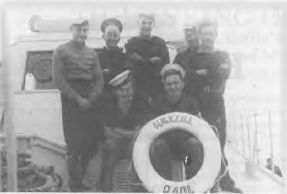- Author
- Cassells, Ken
- Subjects
- History - general, Biographies and personal histories, Ship histories and stories
- Tags
-
- RAN Ships
- None noted.
- Publication
- June 1991 edition of the Naval Historical Review (all rights reserved)
So on 7th February, 1944 the 80th Flotilla left Auckland for the Solomons and on 1st March the 81st sailed. The boats had been regrouped around MLs 403 and 400 which led the 80th and 81st respectively. In the former were MLs 401 to 406 and in the latter MLs 407 to 411 as well as the leader ML 400. The Senior Officers were Lt. H.J. Bull, D.S.C., R.N.Z.N.V.R, in ML 403 and Lt. M.C. Waylen, D.S.C., R.N.Z.N.V.R. in ML 400. Appointed to command the forward base was Lt. Cdr. H.E. Cave, R.N. (Ret). A minor collision in Auckland Harbour a few days before the departure of the 80th saw ML 405’s departure delayed until that of the 81st.
The voyage to the Solomons, although not the longest undertaken by Fairmiles, was quite an exercise and required careful planning. Optimum range was 600 miles and refuelling points had to be arranged. A large escorting vessel with towing gear in case of breakdowns was also considered necessary, particularly in the rougher latitudes.

Rear L. to R:-Seamen Cassells, Randle, Garfield, Lambert and Glidden
Front: Glidden and Willis
I had joined ML 401 the previous June as a newly trained ordinary seaman and like the other fifteen on board was looking forward very much to the voyage. In retrospect it turned out to be one of life’s more noteworthy adventures – not for anything spectacular but for its uniqueness. We were young – seamen’s ages were restricted to 18 to 22 years – and the experience was both demanding and satisfying, for most of us at any rate. Some proved so “unseaworthy” that they had either to be drafted ashore at the forward base or returned to New Zealand.
Our officers were mostly pre-war yachtsmen very suited for the job and generally good leaders. The all important coxwains were often reservists a few jumps ahead of us in experience but the P.O. motor mechanics were on a par with us as far as seatime went but had that real expertise when it came to keeping us mobile. Some were quite remarkable when it came to extending the lives and performance of old and recalcitrant motors.
Sailing from Auckland late afternoon on 7th February we reached Whangaroa in the far north next morning and had our fuel tanks topped up from R.N.Z.A.F. tankers stationed at nearby Waipapakauri aerodrome. Leaving Whangaroa soon after midday the five MLs in line ahead rendezvoused at 1400 with the Scottish Isles class minesweeper H.M.N.Z.S. SCARBA which was to escort us as far as Noumea. On board SCARBA were towing strops in case any of us broke down. With our escort in the van we altered formation so that MLs 403 and 406 flanked her and the remaining three followed abreast.
By 1700 the northernmost tip of N.Z. began to slip over the horizon on our port beam and at 1820 each of the Fairmiles shut down one motor to cruise more economically at 10 knots. The helmsmen had to continually correct their boats’ tendency to yaw. The four seaman Asdic ratings on each boat did all the steering except when the more experienced services of the cox’n were needed. At the helm we also carried out a listening watch which made it necessary to have two of us on each watch. To ease the strain of both steering and listening we alternated every hour by standing lookout on the bridge.
A long swell activated by a steady wind from the northwest made conditions `tween decks pretty uncomfortable. We carried four extra hands, members of the spare crew the five boats shared. These chaps had to bunk down on the mess deck. Into the next day we began shipping water and their location became untenable. Seasickness also took its toll and by nightfall only those of us immune to it were able to carry on effectively, Cooking was out and the only way we could boil water was by one holding a primus and another making sure the kettle stayed on top. Tinned coffee and milk with sardines on bread became our staple diet. Watching the antics of the other MLs was fascinating, particularly as you knew you were doing the same thing, The SCARBA shipped heavy seas continually showing her blunt stern and racing propeller as she plunged forward. The MLs faced the rollers by climbing up and over them. One moment bows would be pointing skyward then as the roller reached the keel’s mid-point there would be an almighty shudder and a burying plunge. This would lift out the stem and the working propeller would race like nobody’s business. The skipper all the time had to work out a compromise between maintaining way and station and preventing undue motor and bearing strain.
At 1330 on 10th February Norfolk Island hove in sight and as we closed in, conditions abated. We reported to Kingston for berthing orders and an R.N.Z.A.F. launch directed us to Sydney Bay. There we dropped anchors and prepared for next day’s refuelling from lighters carrying 44 gallon drums of aviation spirit. A wind shift during the night forced us to move to Ball Bay where replenishment began next morning. Later we were given a run ashore but as soon as we returned another move because of the changing wind became necessary. This time it was to Cascade Bay where fuelling and watering were completed. While all this was going on one ML maintained an off-shore A/S screen. By 1400 we were ready for sea again and SCARBA rejoined us for the 48 hour run to Noumea, New Caledonia.




